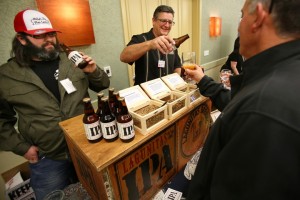
Kevin Lynch, center, with Lagunitas Brewing, pours samples of India Pale Ale and Brown Shugga during the Sonoma County Beer, Cider and Spirits Conference in Santa Rosa on Tuesday. Connor Jay photo
It is very hard to summarize four hours of talking in a few hundred words, but that’s what newspapers are all about, so here’s our report on yesterday’s well-attended Sonoma County Beer, Cider, and Spirits conference. But of course, there was much (much) more than I couldn’t squeeze in there, so here’s a few other highlights.
First, despite being on stage for about 30 minutes or so as keynote speaker, Laguintas founder Tony Magee only said one four-letter word, an unusual level of restraint for the normally colorful brew baron. He admitted afterward that he was trying to do better in speeches, but he did let a few “frickin”s drop. He’s getting a little more used to public speaking now that he’s famous, he said. In fact. he had some amusing stories about public speaking yesterday. He told, for example, about how he recently addressed a room full of MillerCoors distributors in Florida (that alone should be a punchline).
“I told them I come from the future,” Tony said.
The distributors seemed baffled by his stories about the West Coast, where craft beer is an everyday thing in stores, restaurants, bars, and beer-drinking homes, he said.
“It was about like I’m talking to them from another world,” he said. “It does not reflect their environment yet.”
In another recent speech, he spoke to MBA students at Dartmouth, an effort to recruit promising young talent to become the second generation of management at Lagunitas. Here Tony met his own baffling future, with clean-cut young financial professionals flocking to be part of the shaggy beard-and-tattoo culture of craft brewing.
“The best and brightest minds are being drawn to craft brewing,” he said. “They’re turning their backs on he morass and soulessness of Wall Street.”
But wait, does that mean Tony is planning to retire and turn the company over to a bunch of biz school grads? No way, he said, repeating his insistence that he is “On the die-on-payroll plan” at Lagunitas. As to where the company goes in the future, he said, “I’m going to see how far it goes before it blows up.”
He had one interesting prediction – that the era of the Lager may be over after a more than a century of dominance in the beer world. By 2050, he said, the IPA may be the new standard throughout the beer world, as it already is in the craft beer subculture. That spells trouble for big brands like Budweiser and Coors, which are lager based, and may even present a challenge for craft brewing pioneer Sam Adams, which continues to center its line on the flagship Boston Lager. Tony has always been somewhat dismissive of Sam Adams and yesterday was no exception: he suggested that the company’s early success may have been because its early offering was a lager that was closer to the popular taste in the 1980s than the hoppy ales that are increasingly popular and that its continued loyalty to the fading style may present “some challenges.”
Tony had a funny metaphor for the decline of the big brewers, who still dominate the market but are losing market share rapidly. He looked back to the American Civil War, noting how the Union made an early effort to seize the port of New Orleans. That cut off the South’s access to foreign export markets, taking with it the hard currency the Confederacy needed to pay for its army. The day New Orleans fell, Tony said, the war was effectively over, even though there were years more of bloody fighting to come.
He then referred back to the day in 2008 when Budweiser announced it would offer “American Ale.”
“New Orleans fell that day,” Tony said. “They gave everybody who was a Budweiser drinker, or otherwise a macro beer drinker, permission to leave the reservation” and explore better flavors.
“If the tail can wag the dog that hard, that Lagunitas, and Russian River, and Petaluma Hills and Sierra Nevada and Anchor can compel Anheuser-Busch to make an American Ale – I say if the tail is wagging the dog that hard, it’s not the tail anymore,” he said.
In addition to the big think stuff, of course, there was a lot of technical chatter at the conference yesterday. A couple of themes stand out.
One was that banks and investors are taking the beer industry more and more seriously and are more willing than ever to lend. But remembering the industry contraction that killed many small brewers in the 1990s, the lenders are demanding strong, well-thought-out business plans and they are securing loans against hard assets such as fermenting tanks and brewing systems. That implies two things: first, that they expect at least some brewers to fail, since they are demanding hard, sellable assets to back the loans. Second, they see a strong future for the market despite those failures, since the tanks and brew kettles of bankrupt breweries would be worthless if the industry in general weren’t healthy.
Speaking of which, one of the challenges start up brewers face, industry types said, is a lack of used equipment. For the past 15 years, new brewers have been able to count on a steady supply of quality used equipment at decent prices from that first wave of brewery failures in the 1990s. Now that used market has dried up, meaning a startup or expanding brewery is going to have to expect to pay a premium for brand new equipment.
The glut of breweries has also put huge pressure on ingredients. The hops industry has always been fairly small, and barley farmers are under ever-greater pressure to switch to corn and other more profitable staple crops. With craft brewing booming worldwide, however, the squeeze is already on for premium ingredients, brewers warned.
“”You can just see the train wreck coming,” Tony said.
Natalie Cilurzo of Russian River warned newer brewers to make sure to lock themselves into at least three years of contracts on hops and malt to make sure they have a steady supply.
Regulatory issues remain a huge hurdle, they all said. Despite the increasingly favorable legal environment for brewers, tax policy, label requirements, and wastewater quality rules remain daunting.
State Assembly member Wes Chesbro, the leader of the informal “craft brew caucus” in the legislature, said there remain many parts of the state’s alcohol code that don’t make sense. He didn’t outline any specific legislation he has in mind for his last year in office (he’s term limited out next year), but he hinted that there is plenty more legislative work to do.
“Consumer imagination about what we should be doing to make beer available anywhere and everywhere is growing,” he said, which puts lots of pressure on legislators.
There was less talk at the conference about cider and spirits, though conference-goers agreed that both are increasingly important markets that will follow in beer’s footsteps. David Cordtz of the newly opened Sonoma Cider in Healdsburg is planning an ambitious multi-state rollout of his cider by the end of the year, hoping to capitalize on the interest in craft beer. A major challenge for cider, he said, is that it suffers from something of an identity problem: It is produced (and regulated and taxed) like a wine but sold like a beer – in four- and six packs and on tap. That means a cidermaker with larger ambitions has to learn the world of beer distributors, who are better able to service tap-based restaurants and stores designed for beer packages on the shelf.
On the spirits side, the state’s rigid distribution rules remain the main obstacle, distillers say. Because distillers are are not allowed to sell their products directly to the public, as brewers and winemakers can, they are at the mercy of distributors. Timo Marshall of Spirit Works in Sebastopol said that system prevents them from doing small scale experiments, or unusual products with no market track record, for fear that no distributor would agree to sell the small batches.
Conference organizers, the county Economic Development Board, announced at the end that this year’s event was so successful – a sold out crowd of more than 300 – that they already plan to do it again next year. Also, brewer and industry consultant Kevin McGee, who chaired the committee that helped organize the conference, said he plans to keep the committee together in part as an industry networking center to help promote the brand of Sonoma County and maintain some cohesion among the brewers, cider makers and distillers.
– Sean Scully

 buyer at Fircrest Market in Sebastopol and the administrator of the NorCal Beer Geeks group on Facebook.
buyer at Fircrest Market in Sebastopol and the administrator of the NorCal Beer Geeks group on Facebook.